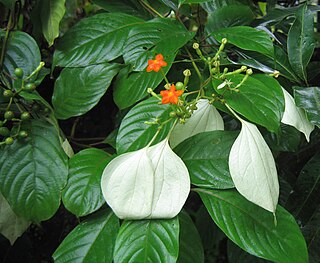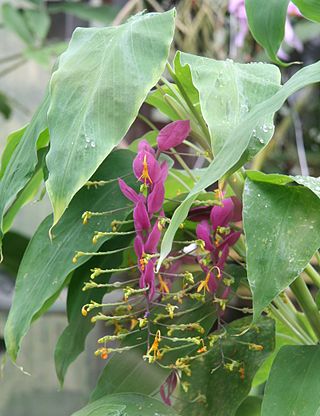
The genus Zingiber is native to Southeast Asia especially in Thailand, China, the Indian Subcontinent, and New Guinea. It contains the true gingers, plants grown the world over for their culinary value. The most well known are Z. officinale and Z. mioga, two garden gingers.

Argyreia is a genus of plants in the family Convolvulaceae.

Aeschynanthus is a genus of about 150 species of evergreen subtropical and tropical plants in the family Gesneriaceae. They are usually trailing epiphytes with brightly colored flowers that are pollinated by sunbirds. The genus name comes from a contraction of aischuno and anthos (flower). The common name for some species is lipstick plant, which comes from the appearance of the developing buds emerging from the calyces. A full list of the accepted species and their synonyms can be found in the Smithsonian Institution's World Checklist of Gesneriaceae.

Brassaiopsis is a genus of shrubs in the family Araliaceae. There are about 45 species, distributed in Asia from the Himalaya through China, Vietnam, Thailand to Indonesia.

Canthium is a genus of flowering plants in the family Rubiaceae. They are shrubs and small trees. The leaves are deciduous and the stems are usually thorny.

Goniothalamus is one of the largest palaeotropical genera of plant in family Annonaceae.

Utricularia caerulea, the blue bladderwort, is a very small to medium-sized carnivorous plant that belongs to the genus Utricularia. U. caerulea spans a wide native range, including areas in tropical Africa, Asia, and Australia. It grows as a terrestrial plant in wet, shallow soils over rock, in wet grasslands, in swamps, or near streams in open communities, mostly at lower altitudes but ascending to as much as 2,100 m (6,890 ft). It was originally described and published by Carl Linnaeus in 1753.

Mussaenda is a genus of flowering plants in the family Rubiaceae. They are native to the African and Asian tropics and subtropics. Several species are cultivated as ornamental plants.

Globba is a genus of plants in the ginger family. It contains about 100 species, native to China, the Indian Subcontinent, Southeast Asia, New Guinea, the Bismarck Archipelago and Queensland.

Microchirita is a genus of flowering plants in the family Gesneriaceae, subfamily Didymocarpoideae.

Codonoboea is a genus of flowering plants in the family Gesneriaceae. Many of its species were formerly placed in the genus Henckelia.

Petrocosmea kerrii is a species of flowering plant in the family Gesneriaceae, sometimes cultivated as a houseplant. In the past, it has been erroneously placed in the genus Damrongia. It was first described by William Grant Craib in 1918.

Erycibe is a genus of plants in the family Convolvulaceae, found in the Andaman Islands, Sri Lanka, India including Assam, Bangladesh, Myanmar, east Himalaya, southern and southeastern China including Hainan and Taiwan, Southeast Asia, Malesia, Papuasia, Australia, and Japan including the Ryukyu Islands.

Friesodielsia is a genus of flowering plants in the custard apple and soursop family Annonaceae, with all species found in the Old World, mostly in the tropics. A molecular study shows that Friesodielsia should be more narrowly circumscribed, with the only species remaining being the Asian ones, which can also be distinguished by their possession of globose or ellipsoid monocarps, and six petals per flower arranged in two whorls.
Paraboea are a genus of flowering plants in the African violet family Gesneriaceae, native to southern China, Assam, Indochina, and Malesia. They were recircumscribed from Boea in 2016.
Anerincleistus is a genus of flowering plants belonging to the family Melastomataceae.
Rachunia is a genus of flowering plants belonging to the family Gesneriaceae.

Ornithoboea is a genus of flowering plants belonging to the family Gesneriaceae.

Sphaerocoryne is a genus of flowering plants belonging to the family Annonaceae.

Rungia is a genus of flowering plants belonging to the family Acanthaceae.

















